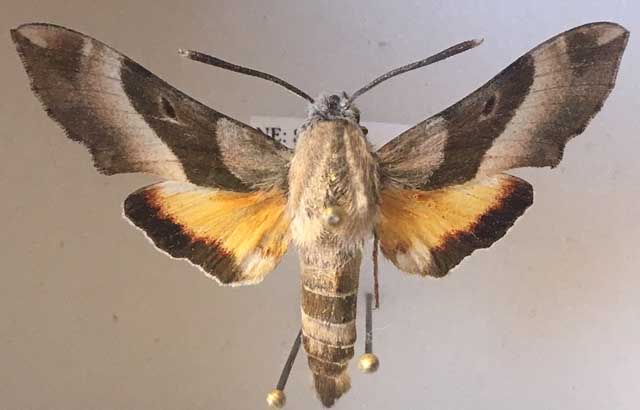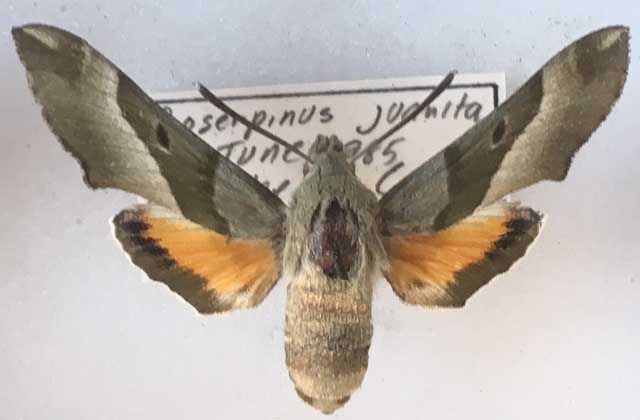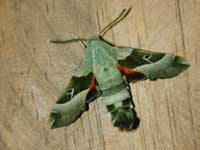Sioux County, northwestern Nebraska and
Dawes, Box Butte and Sheridan Counties
Sphingidae

|
|
Inspired by and dedicated to Derek Bridgehouse, September 10, 2018 Updated as per James P. Tuttle's The Hawk Moths of North America, September 10, 2018 Updated as per BAMONA, September 10, 2018 |

This page is inspired by and dedicated to Derek Bridgehouse who sent me the images of Proserpinus juanita above and below.

Thirty-seven Sphingidae species are listed on BAMONA for Nebraska as of September 9, 2018. Not all of the species are reported (Fourteen are reported by BAMONA as of September 9, 2018) or anticipated in Sioux County in extreme northwestern Nebraska.
Ceratomia amyntor; Ceratomia catalpae; Ceratomia undulosa; Sphinx chersis; Sphinx vashti; Pachysphinx modesta; Paonias excaecata; Paonias myops; Smerinthus jamaicensis; Hemaris diffinis Amphion floridensis; Darapsa myron; Hyles lineata; Proserpinus juanita.
The following species have either been confirmed (BAMONA) in nearby counties or are expected throughout northwestern Nebraska:
Dawes (18): Ceratomia amyntor; Ceratomia undulosa; Manduca quinquemaculata; Sphinx chersis; Sphinx drupiferarum; Sphinx vashti; Pachysphinx modesta; Paonias excaecata; Paonias myops; Smerinthus jamaicensis; Hemaris diffinis; Eumorpha achemon; Amphion floridensis;Darapsa myron; Deidamia inscriptum; Hyles gallii; Hyles lineata; Proserpinus juanita.
Box Butte (0 reported)
Sheridan (8): Ceratomia amyntor; Ceratomia undulosa; Manduca quinquemaculata; Sphinx vashti; Smerinthus jamaicensis; Hemaris diffinis; Hyles lineata; Proserpinus juanita.
It is hoped that this checklist, with the thumbnails and notes, will help you quickly identify the caterpillars you have encountered.
A comment after the species name indicates that I have no confirmed reports of this species in your county, but I (William Oehlke) expect that these moths are present or might occur as occasional strays.
Please help me develop this list with improved, documented accuracy by sending sightings (species, date, location), preferably with an image, via email to Bill Oehlke.
Please also forward your results to BAMONA, an excellent online resource.
Visit Nebraska Catocala (Underwing Moths). You can also visit Sphingidae checklists for all Canadian provinces, all US states, Mexico, and all countries ion Central and South America.
Sphinginae subfamily
Smerinthini Tribe:
Macroglossinae subfamilyDilophonotini Tribe:
See Hemaris comparison
to help distinguish the next two species.
Philampelini Tribe:
Macroglossini Tribe:
|
 |
Proserpinus juanita, the Juanita Sphinx.
Sioux/DB/Dawes/Sheridan |
 | Sphecodina abbottii generally more southeasterly; unlikely, the Abbott's SphinxThis moth is very much under reported on USGS. It is a rapid day flier so is probably not in too many collections. Grape is a popular larval host. |
Enjoy some of nature's wonderments, giant silk moth cocoons.
These cocoons are for sale winter and fall. Beautiful Saturniidae moths will emerge the following spring and summer.
Read Actias luna rearing article.
Additional online help available. Eggs of many North American species are offered during the spring and summer. Occasionally
summer Actias luna and summer Antheraea polyphemus cocoons are available. Shipping to US destinations is done
from with in the US.
This page is brought to you by Bill Oehlke and the
WLSS. Pages are on space rented from Bizland. If you would like to become a "Patron of the Sphingidae Site", contact Bill.
Please send sightings/images to Bill. I will do my best to respond to requests for identification help.
 Show appreciation for this site by clicking on flashing butterfly to the left. The link will take you to a page with links to many insect sites. |
I very much appreciate all the many images that have been sent to me, or of which I have been granted permission to copy and post from other websites. All images on this site remain the property of respective photographers.
If you would like to contribute to the maintenance of this website by sending a contribution to
Bill Oehlke
Box 476
155 Peardon Road
Montague, Prince Edward Island, C0A1R0
Canada
your donation would be much appreciated and would be used for
1) paying for webspace rental;
2) paying for computer maintenance and software upgrades;
3) purchases of additional text reference material (journals and books) in anticipation of expanding the site to a worldwide Sphingidae site;
4) helping to pay my daughter's tuition (completed spring of 2013); with anything left over going to humanitarian aid.
If you are mailing a check from USA, please use $0.85 postage ($1.25 is 2018 rate). Donations can also be made through Paypal via the button below.